2021 NISSAN NV200 child lock
[x] Cancel search: child lockPage 22 of 300
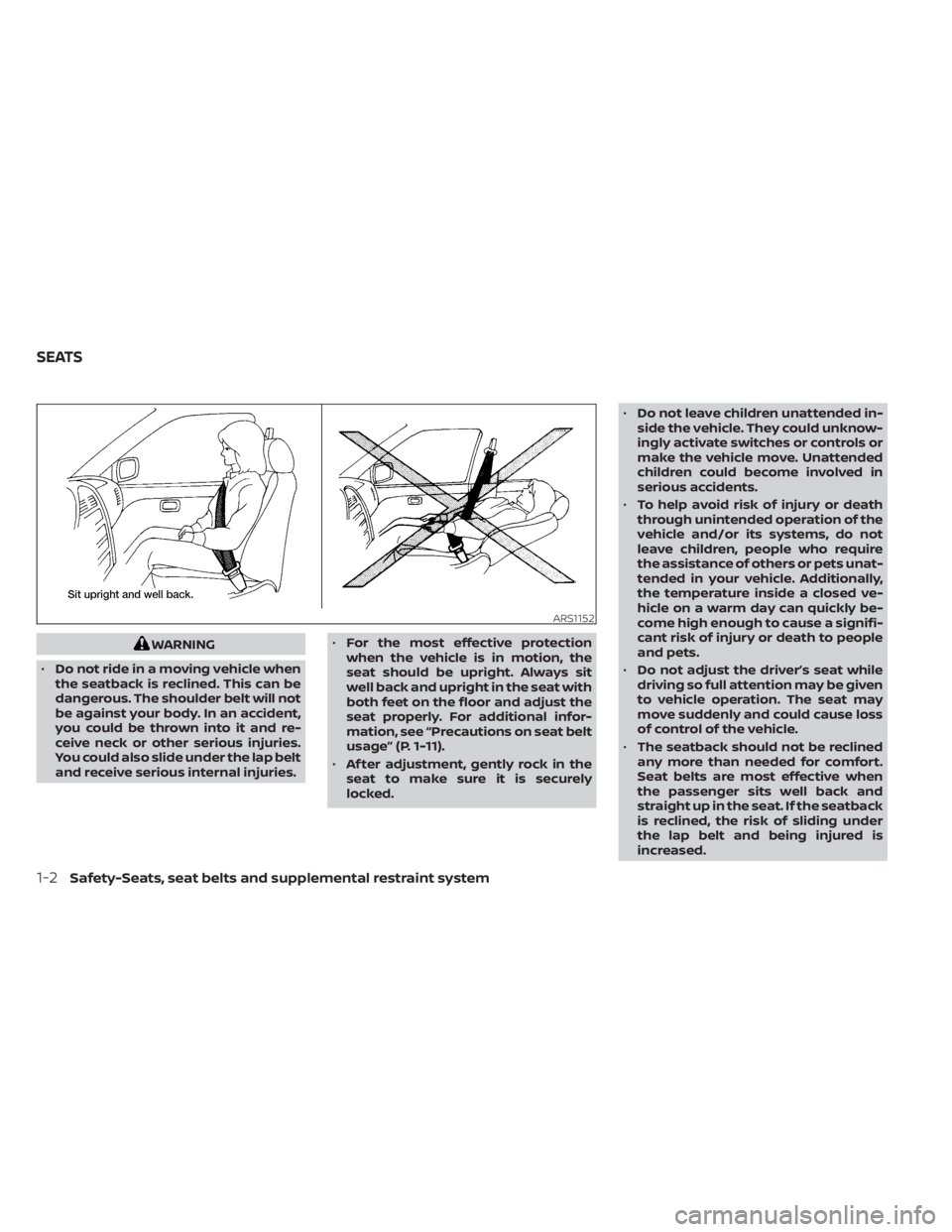
WARNING
• Do not ride in a moving vehicle when
the seatback is reclined. This can be
dangerous. The shoulder belt will not
be against your body. In an accident,
you could be thrown into it and re-
ceive neck or other serious injuries.
You could also slide under the lap belt
and receive serious internal injuries. •
For the most effective protection
when the vehicle is in motion, the
seat should be upright. Always sit
well back and upright in the seat with
both feet on the floor and adjust the
seat properly. For additional infor-
mation, see “Precautions on seat belt
usage” (P. 1-11).
• Af ter adjustment, gently rock in the
seat to make sure it is securely
locked. •
Do not leave children unattended in-
side the vehicle. They could unknow-
ingly activate switches or controls or
make the vehicle move. Unattended
children could become involved in
serious accidents.
• To help avoid risk of injury or death
through unintended operation of the
vehicle and/or its systems, do not
leave children, people who require
the assistance of others or pets unat-
tended in your vehicle. Additionally,
the temperature inside a closed ve-
hicle on a warm day can quickly be-
come high enough to cause a signifi-
cant risk of injury or death to people
and pets.
• Do not adjust the driver’s seat while
driving so full attention may be given
to vehicle operation. The seat may
move suddenly and could cause loss
of control of the vehicle.
• The seatback should not be reclined
any more than needed for comfort.
Seat belts are most effective when
the passenger sits well back and
straight up in the seat. If the seatback
is reclined, the risk of sliding under
the lap belt and being injured is
increased.
Page 35 of 300
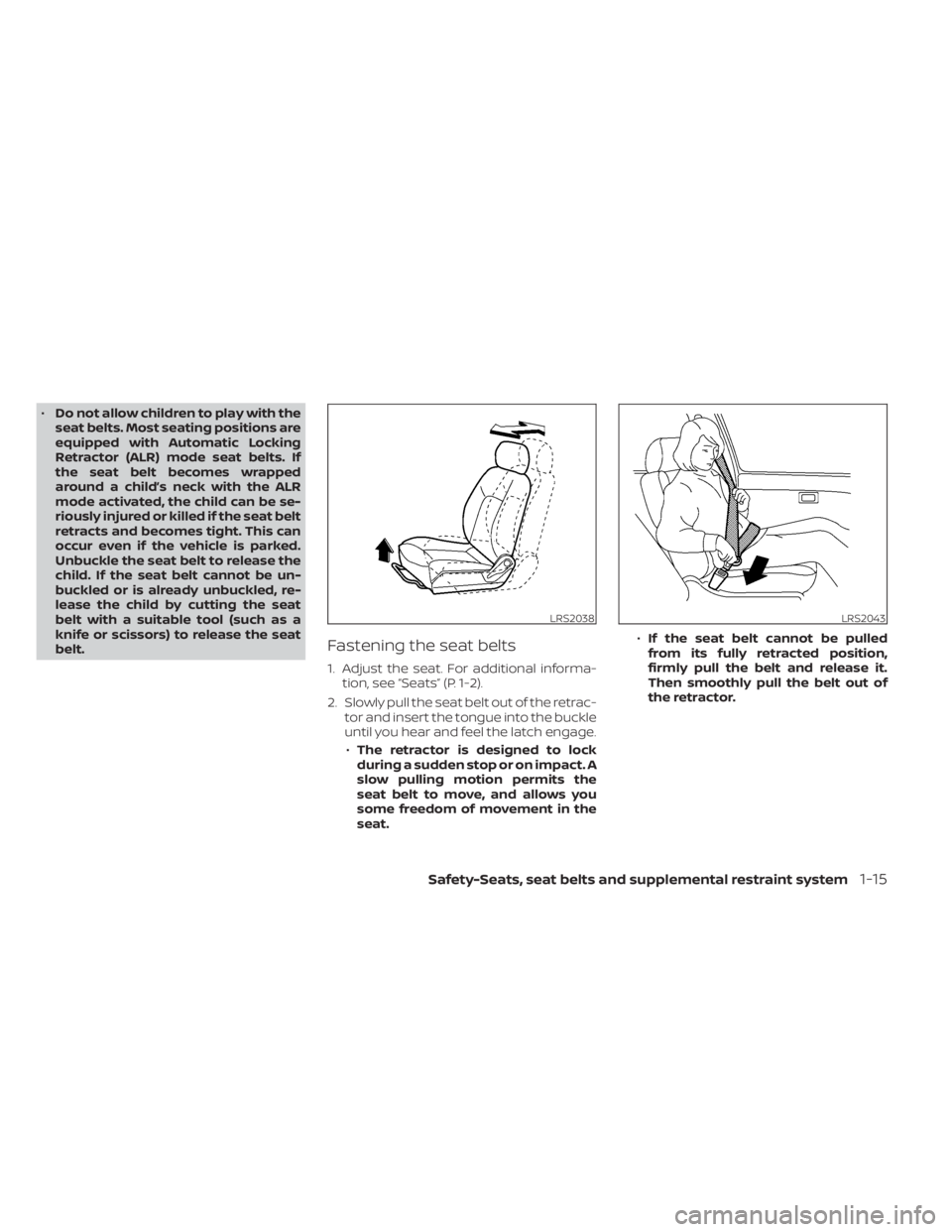
•Do not allow children to play with the
seat belts. Most seating positions are
equipped with Automatic Locking
Retractor (ALR) mode seat belts. If
the seat belt becomes wrapped
around a child’s neck with the ALR
mode activated, the child can be se-
riously injured or killed if the seat belt
retracts and becomes tight. This can
occur even if the vehicle is parked.
Unbuckle the seat belt to release the
child. If the seat belt cannot be un-
buckled or is already unbuckled, re-
lease the child by cutting the seat
belt with a suitable tool (such as a
knife or scissors) to release the seat
belt.
Fastening the seat belts
1. Adjust the seat. For additional informa- tion, see “Seats” (P. 1-2).
2. Slowly pull the seat belt out of the retrac- tor and insert the tongue into the buckle
until you hear and feel the latch engage.
• The retractor is designed to lock
during a sudden stop or on impact. A
slow pulling motion permits the
seat belt to move, and allows you
some freedom of movement in the
seat. •
If the seat belt cannot be pulled
from its fully retracted position,
firmly pull the belt and release it.
Then smoothly pull the belt out of
the retractor.
LRS2043
Page 36 of 300
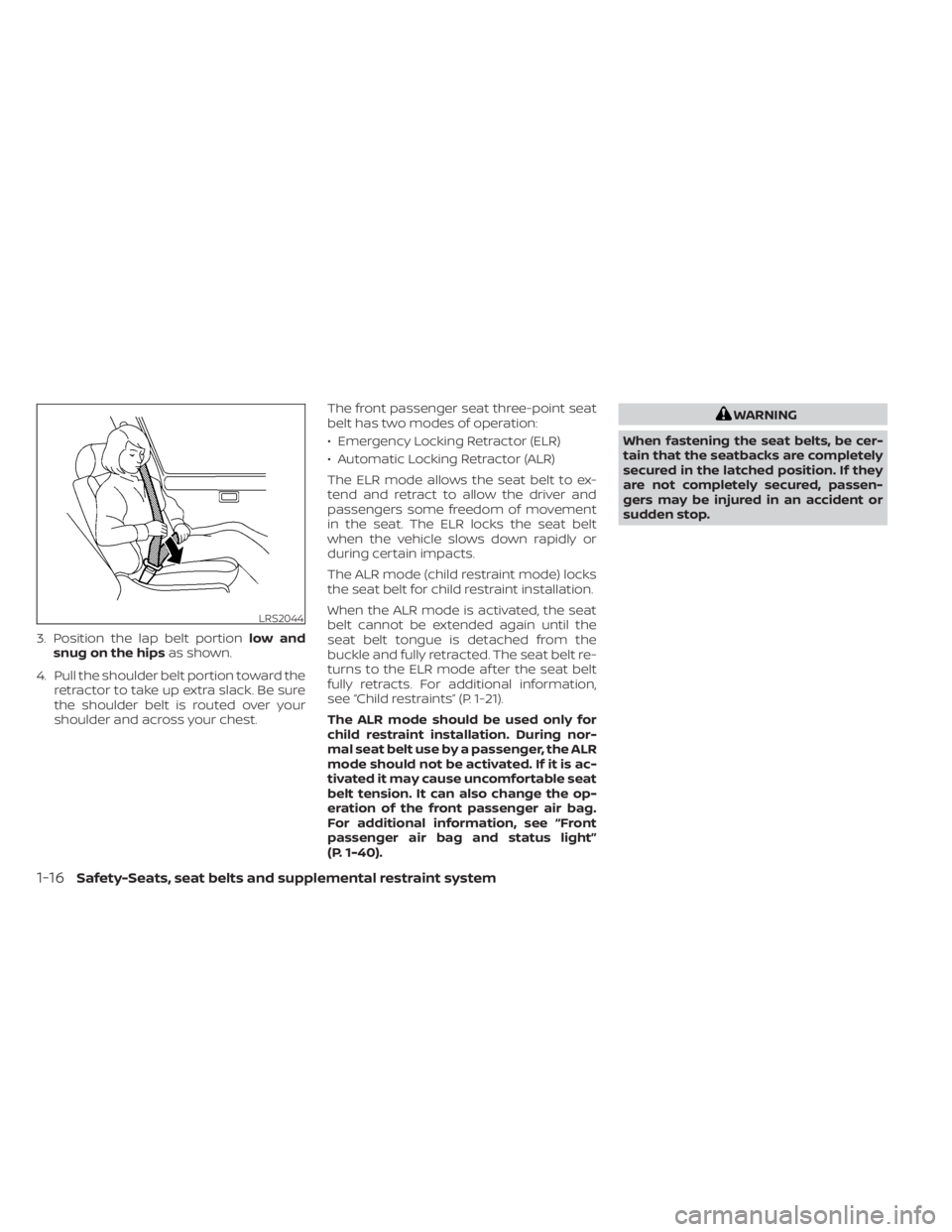
3. Position the lap belt portionlow and
snug on the hips as shown.
4. Pull the shoulder belt portion toward the retractor to take up extra slack. Be sure
the shoulder belt is routed over your
shoulder and across your chest. The front passenger seat three-point seat
belt has two modes of operation:
• Emergency Locking Retractor (ELR)
• Automatic Locking Retractor (ALR)
The ELR mode allows the seat belt to ex-
tend and retract to allow the driver and
passengers some freedom of movement
in the seat. The ELR locks the seat belt
when the vehicle slows down rapidly or
during certain impacts.
The ALR mode (child restraint mode) locks
the seat belt for child restraint installation.
When the ALR mode is activated, the seat
belt cannot be extended again until the
seat belt tongue is detached from the
buckle and fully retracted. The seat belt re-
turns to the ELR mode af ter the seat belt
fully retracts. For additional information,
see “Child restraints” (P. 1-21).
The ALR mode should be used only for
child restraint installation. During nor-
mal seat belt use by a passenger, the ALR
mode should not be activated. If it is ac-
tivated it may cause uncomfortable seat
belt tension. It can also change the op-
eration of the front passenger air bag.
For additional information, see “Front
passenger air bag and status light”
(P. 1-40).
WARNING
When fastening the seat belts, be cer-
tain that the seatbacks are completely
secured in the latched position. If they
are not completely secured, passen-
gers may be injured in an accident or
sudden stop.
1-16Safety-Seats, seat belts and supplemental restraint system
Page 39 of 300
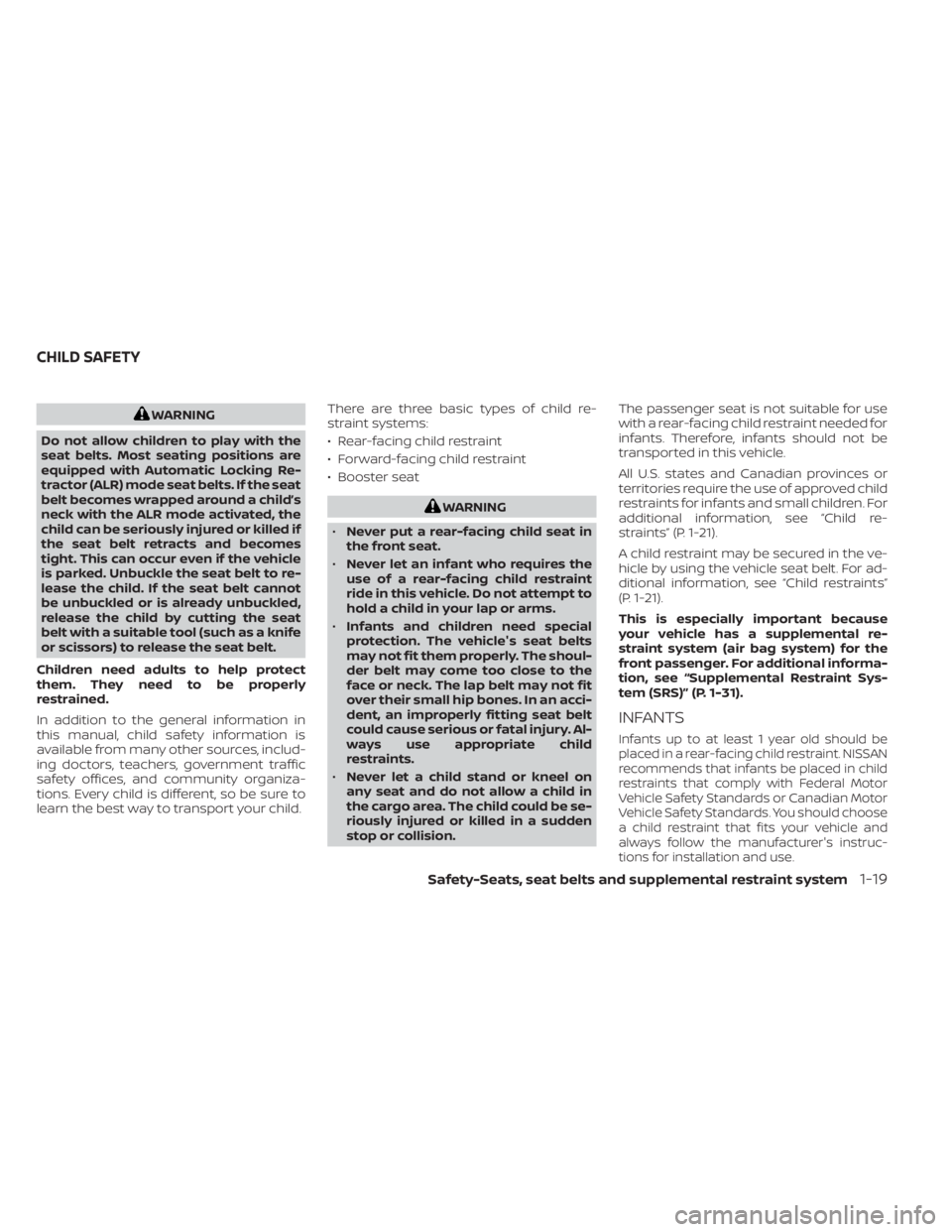
WARNING
Do not allow children to play with the
seat belts. Most seating positions are
equipped with Automatic Locking Re-
tractor (ALR) mode seat belts. If the seat
belt becomes wrapped around a child’s
neck with the ALR mode activated, the
child can be seriously injured or killed if
the seat belt retracts and becomes
tight. This can occur even if the vehicle
is parked. Unbuckle the seat belt to re-
lease the child. If the seat belt cannot
be unbuckled or is already unbuckled,
release the child by cutting the seat
belt with a suitable tool (such as a knife
or scissors) to release the seat belt.
Children need adults to help protect
them. They need to be properly
restrained.
In addition to the general information in
this manual, child safety information is
available from many other sources, includ-
ing doctors, teachers, government traffic
safety offices, and community organiza-
tions. Every child is different, so be sure to
learn the best way to transport your child. There are three basic types of child re-
straint systems:
• Rear-facing child restraint
• Forward-facing child restraint
• Booster seat
Page 294 of 300
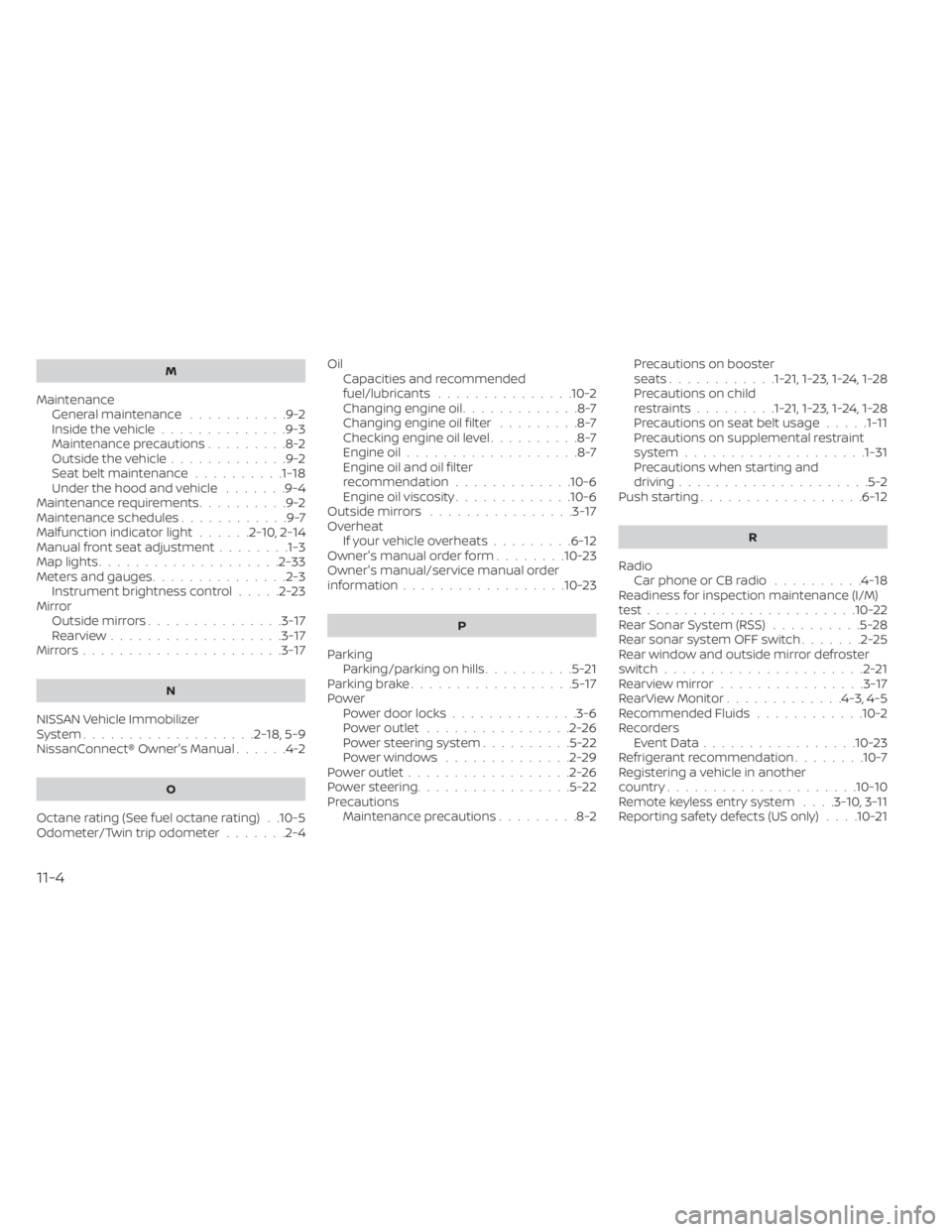
M
MaintenanceGeneral maintenance...........9-2Inside the vehicle..............9-3Maintenance precautions.........8-2Outside the vehicle.............9-2Seat belt maintenance..........1-18Under the hood and vehicle.......9-4Maintenance requirements..........9-2Maintenance schedules............9-7Malfunction indicator light......2-10,2-14Manual front seat adjustment........1-3Map lights................... .2-33Meters and gauges...............2-3Instrument brightness control.....2-23Mirror
Outside mirrors...............3-17Rearview...................3-17Mirrors......................3-17
N
NISSAN Vehicle Immobilizer
System...................2-18,5-9NissanConnect® Owner's Manual......4-2
O
Octane rating (See fuel octane rating). .10-5Odometer/Twin trip odometer.......2-4
OilCapacities and recommended
fuel/lubricants
...............10-2Changing engine oil.............8-7Changing engine oil filter.........8-7Checking engine oil level..........8-7Engine oil...................8-7Engine oil and oil filter
recommendation.............10-6Engine oil viscosity.............10-6Outside mirrors................3-17OverheatIf your vehicle overheats.........6-12Owner's manual order form........10-23Owner's manual/service manual order
information................. .10-23
P
Parking
Parking/parking on hills..........5-21Parking brake..................5-17PowerPower door locks..............3-6Power outlet................2-26Power steering system..........5-22Power windows..............2-29Power outlet..................2-26Power steering.................5-22PrecautionsMaintenance precautions.........8-2
Precautions on booster
seats............1-21,1-23,1-24,1-28Precautions on child
restraints.........1-21,1-23,1-24,1-28Precautions on seat belt usage.....1-11Precautions on supplemental restraint
system................... .1-31Precautions when starting and
driving.....................5-2Push starting..................6-12
R
Radio
Car phone or CB radio..........4-18Readiness for inspection maintenance (I/M)
test...................... .10-22Rear Sonar System (RSS)..........5-28Rear sonar system OFF switch.......2-25Rear window and outside mirror defroster
switch......................2-21Rearview mirror................3-17RearView Monitor.............4-3, 4-5Recommended Fluids............10-2Recorders
Event Data................ .10-23Refrigerant recommendation........10-7Registering a vehicle in another
country.................... .10-10Remote keyless entry system. . . .3-10, 3-11Reporting safety defects (US only). . . .10-21
11-4
Page 295 of 300
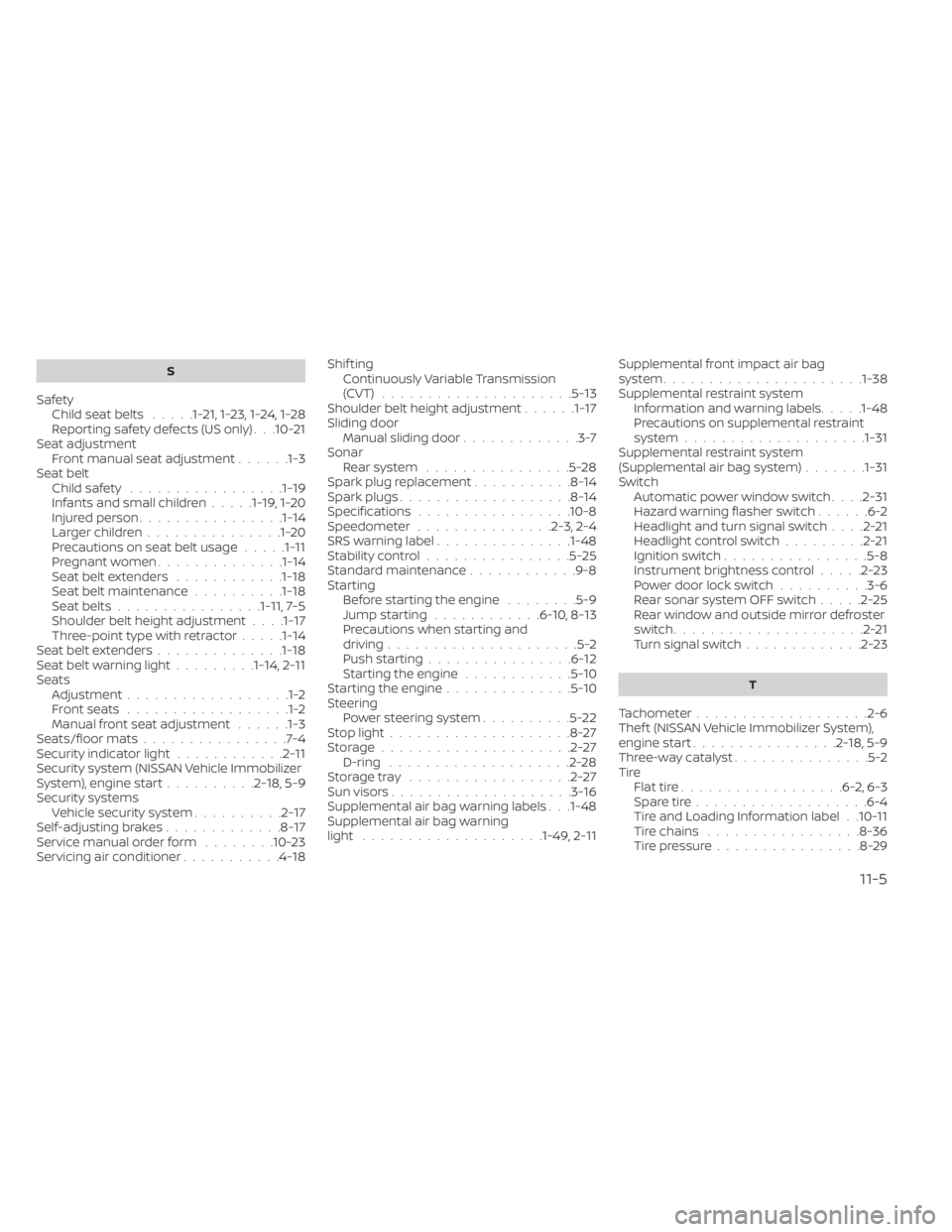
S
SafetyChild seat belts.....1-21,1-23,1-24,1-28Reporting safety defects (US only). . .10-21Seat adjustmentFront manual seat adjustment......1-3Seat beltChild safety.................1-19Infants and small children.....1-19,1-20Injured person................1-14Larger children...............1-20Precautions on seat belt usage.....1-11Pregnant women..............1-14Seat belt extenders............1-18Seat belt maintenance..........1-18Seat belts................1-11,7-5Shoulder belt height adjustment. . . .1-17Three-point type with retractor.....1-14Seat belt extenders..............1-18Seat belt warning light.........1-14,2-11SeatsAdjustment..................1-2Front seats..................1-2Manual front seat adjustment......1-3Seats/floor mats................7-4Security indicator light............2-11Security system (NISSAN Vehicle Immobilizer
System), engine start..........2-18,5-9Security systemsVehicle security system..........2-17Self-adjusting brakes.............8-17Service manual order form........10-23Servicing air conditioner...........4-18
Shif tingContinuously Variable Transmission
(CVT)
.....................5-13Shoulder belt height adjustment......1-17Sliding doorManual sliding door.............3-7SonarRear system................5-28Spark plug replacement...........8-14Spark plugs...................8-14Specifications................ .10-8Speedometer...............2-3, 2-4SRS warning label...............1-48Stability control................5-25Standard maintenance............9-8Starting
Before starting the engine........5-9Jump starting............6-10,8-13Precautions when starting and
driving.....................5-2Push starting................6-12Starting the engine............5-10Starting the engine..............5-10SteeringPower steering system..........5-22Stop light....................8-27Storage.....................2-27D-ring....................2-28Storage tray..................2-27Sun visors....................3-16Supplemental air bag warning labels. . .1-48Supplemental air bag warning
light................... .1-49, 2-11
Supplemental front impact air bag
system..................... .1-38Supplemental restraint system
Information and warning labels.....1-48Precautions on supplemental restraint
system................... .1-31Supplemental restraint system
(Supplemental air bag system).......1-31Switch
Automatic power window switch. . . .2-31Hazard warning flasher switch......6-2Headlight and turn signal switch. . . .2-21Headlight control switch.........2-21Ignition switch................5-8Instrument brightness control.....2-23Power door lock switch..........3-6Rear sonar system OFF switch.....2-25Rear window and outside mirror defroster
switch.....................2-21Turn signal switch.............2-23
T
Tachometer.................. .2-6Thef t (NISSAN Vehicle Immobilizer System),
engine start................2-18,5-9Three-way catalyst...............5-2Tire
Flat tire..................6-2,6-3Spare tire.................. .6-4Tire and Loading Information label. .10-11Tire chains.................8-36Tire pressure................8-29
11-5
Page 296 of 300
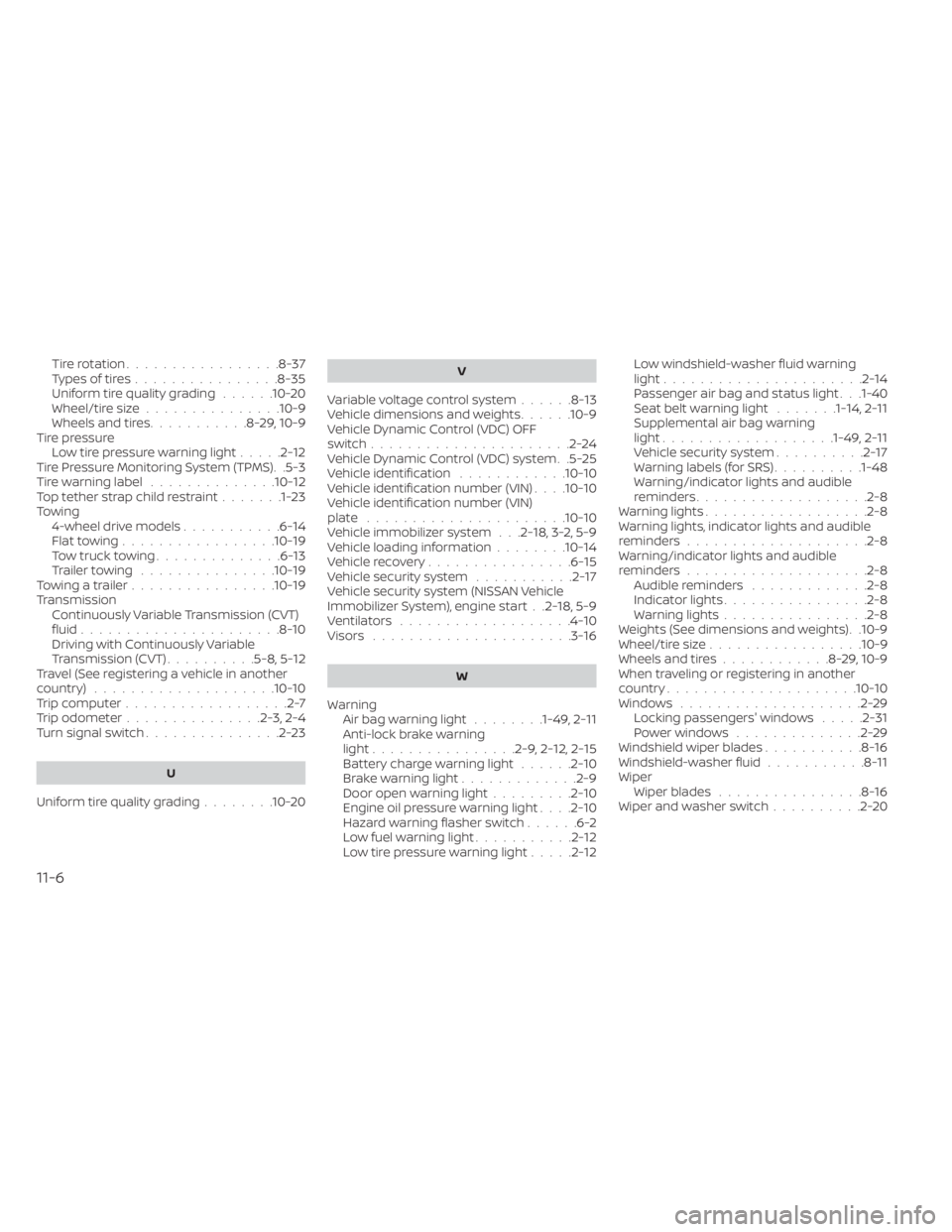
Tire rotation.................8-37Types of tires................8-35Uniform tire quality grading......10-20Wheel/tire size...............10-9Wheels and tires...........8-29,10-9Tire pressure
Low tire pressure warning light.....2-12Tire Pressure Monitoring System (TPMS). .5-3Tire warning label..............10-12Top tether strap child restraint.......1-23Towing4-wheel drive models...........6-14Flat towing................ .10-19Tow truck towing..............6-13Trailer towing...............10-19Towing a trailer................10-19Transmission
Continuously Variable Transmission (CVT)
fluid
......................8-10Driving with Continuously Variable
Transmission (CVT)..........5-8, 5-12Travel (See registering a vehicle in another
country)................... .10-10Trip computer..................2-7Trip odometer...............2-3, 2-4Turn signal switch...............2-23
U
Uniform tire quality grading........10-20
V
Variable voltage control system......8-13Vehicle dimensions and weights......10-9Vehicle Dynamic Control (VDC) OFF
switch......................2-24Vehicle Dynamic Control (VDC) system. .5-25Vehicle identification............10-10Vehicle identification number (VIN). . . .10-10Vehicle identification number (VIN)
plate..................... .10-10Vehicle immobilizer system. . .2-18, 3-2, 5-9Vehicle loading information........10-14Vehicle recovery................6-15Vehicle security system...........2-17Vehicle security system (NISSAN Vehicle
Immobilizer System), engine start. .2-18, 5-9Ventilators...................4-10Visors......................3-16
W
Warning
Air bag warning light........1-49, 2-11Anti-lock brake warning
light................2-9, 2-12, 2-15Battery charge warning light......2-10Brake warning light.............2-9Door open warning light.........2-10Engine oil pressure warning light. . . .2-10Hazard warning flasher switch......6-2Low fuel warning light...........2-12Low tire pressure warning light.....2-12
Low windshield-washer fluid warning
light......................2-14Passenger air bag and status light. . .1-40Seat belt warning light.......1-14,2-11Supplemental air bag warning
light.................. .1-49, 2-11Vehicle security system..........2-17Warning labels (for SRS)..........1-48Warning/indicator lights and audible
reminders...................2-8Warning lights..................2-8Warning lights, indicator lights and audible
reminders................... .2-8Warning/indicator lights and audible
reminders....................2-8Audible reminders.............2-8Indicator lights................2-8Warning lights................2-8Weights (See dimensions and weights). .10-9Wheel/tire size.................10-9Wheels and tires............8-29,10-9When traveling or registering in another
country.................... .10-10Windows....................2-29Locking passengers' windows.....2-31Power windows..............2-29Windshield wiper blades...........8-16Windshield-washer fluid...........8-11Wiper
Wiper blades................8-16Wiper and washer switch..........2-20
11-6